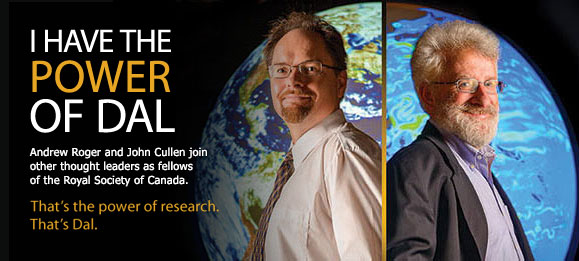
Andrew Roger (PhD’97): Evolutionary Detective
By Mark Campbell
Approximately one and a half to two billion years ago, a remarkable thing happened: the very first single cell organisms on earth began to evolve. As they evolved, they gave rise to a vast and diverse array of plant and animal life. That much we know. But what we don’t fully comprehend is why or how this happened.
It’s a big question, and deep one, and it has preoccupied Dalhousie University researcher and professor of Biochemistry and Molecular Biology Dr. Andrew Roger (PhD’97) for years. “This is not like other sciences where you arrive at an answer by testing the here and now,” he explains. “Evolutionary biology is an attempt to reconstruct how the genes of organisms originated, when, what ancestors they shared and how they’ve mutated since then.”
Such a complex topic may be difficult to explain in casual conversation. But what Dr. Roger is doing is essentially to work out the fundamentals of the ‘the tree of life,’ and how the different branches of life – plant and animals, for example, all sprouted. Most of his work has focused on one super kingdom of organisms referred to as Excavata. This diverse group of single-cell organisms – some free living, others parasitic – is approximately 1.5-2 billion years old, and Dr. Roger is particularly interested in one microbe known as a Blastocystis.
“Some estimates suggest as many as one billion people have it in their guts,” says Dr. Roger. “It’s quite common among people who have irritable bowel syndrome. But it’s unclear if it has a role in causing this disease, such as combining with other bacteria in your guts to cause it. We’re trying to characterize the total genomic composition of the Blastocystis and its biology to see if it has genes that are involved in causing such diseases.”
Equipping researchers worldwide
This is, according to Dr. Roger, early stage work – a foundation for other researchers to explore possible intestinal disease treatments that target the Blastocystis. It is, he cautions, only a possibility, and even if his research leads to treatments, there is the very real possibility that parasites such as this can develop resistance through mutation. “But without genomic data, we don’t even know where to start with developing treatments, and that’s what we’re gathering.”
Along the way, Dr. Roger and his colleagues have developed several computer programs and methodologies to analyze genetic data that are now being used in labs around the world. “Researchers in this field now have new tools to examine genomic data and develop statistical models of how they evolved through the work we’ve been doing.”
| The significance of Dr. Roger’s work is such that he was named a fellow of the Royal Society of Canada last fall. “It’s quite an honour in that it is recognition from your peers that you’ve done something of value. Being named a fellow isn’t directly related to the societal impact of the work you do, but more about how your work has an impact on our understanding of science and biology.” |  “A “Royal” recognition for Dal scientists: New Royal Society fellows John Cullen and Andrew Roger,” Dal News, September 2012. “A “Royal” recognition for Dal scientists: New Royal Society fellows John Cullen and Andrew Roger,” Dal News, September 2012. |
Dr. Roger’s interest in and understanding of biology began in Penticton, BC where, as a young boy, he gathered pond water samples to examine under his microscope. It wasn’t until late in his undergraduate studies at the University of BC in Vancouver that he began to explore evolutionary biology.
“I was involved in an honours project examining how the genome of coral was related to that of other animals in the lab,” he recalls. “Though we know now there is a clear relation between them, there was considerable debate over this issue in the late 80s. I was using genetic data available at the time to tackle that question.”
Joining the Dal community
Having found his passion, Dr. Roger decided to pursue it further at Dalhousie University, which was – and remains – a recognized leader in studying the mechanics of evolution. “Dalhousie had prominent researchers, like Dr. Ford Doolittle, who were well funded by grant agencies. It had a large complement of students and post-doctoral researchers. There was an amazing community here, and I knew that by being part of it I would learn the fundamentals for making progress in my own research.”
It was that large complement of researchers that brought Dr. Roger back to the university as a professor and researcher following a post-doctoral fellowship at the Marine Biological Laboratory in Massachusetts.
“I don’t think there is any other university with faculty members specializing in all fields of microbial genetic evolution, from the discovery of the genome to development of statistical models on how those genomes evolved. Also, the size of Dalhousie is such that it is easy for the faculty to come together and collaborate. So it made sense to start my own lab here.”
As for the future, Dr. Roger remains focused on his lifelong goal: to understand how we evolved from the first organisms on the planet to the super kingdoms we have today. “I want to understand how the tree of life evolved and how events in nature changed the way the genomes work. I will continue to do what I do to make the murky picture of how life evolved on this planet much clearer.”